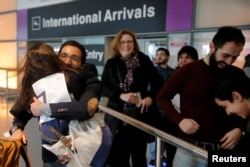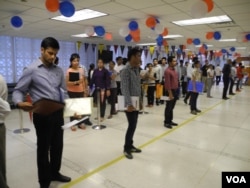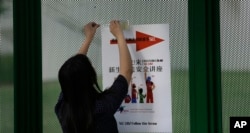Many of the U.S. colleges and universities that are most popular among foreign students are reporting an increase in international applicants, despite surveys earlier this year that warned of a drop.
VOA Student Union contacted 20 schools with the largest populations of foreign students. Fourteen institutions reported that international applications from undergraduates increased or remained stable. Six reported drops. Collectively, the schools account for about 20 percent of all foreign students studying at U.S. universities and colleges.
The final tally of foreign students who applied and enrolled in American universities each year is not publicly reported until November. For now, the VOA survey indicates that foreign students’ interest remains high and the number of foreigners choosing to study in America continues to grow after topping one million for the first time in the 2015-16 school year.
A few months ago, a survey of the schools indicated declining interest from foreigners. The Institute for International Education (IIE) conducted a survey in March of 250 schools nationwide, showing a nearly 40 percent decline in applications from foreign students. The survey was conducted shortly after President Donald Trump issued a travel ban on immigrants — including students — from six Muslim-majority countries.
That would have barred travelers from Iran, Libya, Syria, Sudan, Somalia and Yemen from entering the country for 90 days. However, federal courts struck down or suspended much of the measure. The U.S. Supreme Court allowed parts of the ban to take effect in late June. Students from the affected countries who hold valid visas can still travel to the U.S. for their studies.
But it was unclear whether many students would choose not to pursue an American university degree given the uncertainty around the immigration measures.
Recent IIE numbers
Last month, IIE followed up with another study that showed the decline in applications had narrowed to within 2 percent of last year's application numbers.
Contacted by VOA Student Union this week, 14 schools reported increases or remained close to last year's applications: New York University, University of Southern California, Columbia University, University of Illinois-Urbana/Champaign, Northeastern University, University of California-Los Angeles, Boston University, Michigan State University, Pennsylvania State University, University of Michigan, University of California-San Diego, University of California-Berkeley, Indiana University and Ohio State University.
Six schools that reported decreases in applications are Arizona State University, Purdue University, University of Texas-Dallas, University of Washington, University of Minnesota and Carnegie Mellon University. The declines ranged from drops of 1,000 applications this year to drops of a few hundred. Not all schools released specific numbers.
The application figures are preliminary, the schools noted. Final figures will be computed in mid-September or later for most schools, after the withdrawal period for classes has ended.
Top school sees boost
New York University, which hosts the most international students, according to IIE, received about 20,000 international undergraduate applications for the Class of 2021. This accounts for 27 percent of its applicant pool and an increase of about 1,500 applications from last year, according to Shawn Abbott, NYU's dean of admissions.
Ohio State University spokesperson Benjamin Johnson said that while applications increased by 10 percent over last year, it admitted 4.4 percent fewer foreign students to keep in line its planned student-body composition.
Northeastern University, which had 11,702 international students last year, saw an increase in international applicants, said Northeastern spokesperson Matthew McDonald.
The leading countries of origin of international students are China (31 percent), India (16 percent), Saudi Arabia (6 percent) and South Korea (6 percent). They account for nearly 60 percent of last year's more than 1 million international students in the U.S., the IIE report stated.
International students contributed $32.8 billion to the U.S. economy during the 2015-16 school year, making the program the 12th largest service-sector industry in the U.S.
In November, IIE will release its 2017 annual report with statistics for all schools and foreign populations.
This report has been amended from its original version to include data from Carnegie Mellon University.













